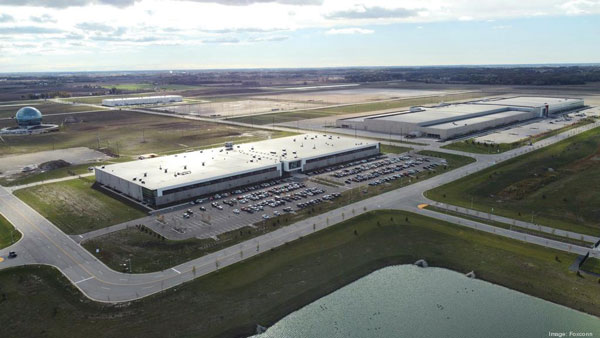“Ithink it’s important for us to keep in mind that it wasn’t conflict and confusion, it was a changing marketplace, and the market changed for Foxconn,” says Wisconsin Economic Development Corporation (WEDC) Secretary and CEO Missy Hughes of the pitfalls of the $10 billion, 13,000-job display panel manufacturing facility Foxconn had planned to establish in Mount Pleasant.
From the original investment announcement in 2017 and the subsequent groundbreaking a year later until now, Foxconn has taken a significant step back on its original project promises. The newly established, 2,400-acre Wisconn Valley Science and Technology Park never saw the proposed Generation 10.5 liquid crystal display plant come to fruition.
Instead, Foxconn amended its agreement with the state in 2021 to reflect a far lower $672 million total investment, just over 1,400 jobs and a $2.05 billion (now $80 million) cut to WEDC’s performance-based tax credit incentive package. Although the company left more to be desired, Wisconsin remained flexible.
Phase 1 of development produced a nearly 1-million-sq.-ft. Advanced Manufacturing Facility, a 300,000-sq.-ft. Smart Manufacturing Center, a 120,000-sq.-ft. Multipurpose Building and a High-Performance Computing Data Center Globe. While no 8K LCD display panels have been produced as of yet, the company has said it is manufacturing data servers for an undisclosed client.
Fortunately, the prime location of the park, the over $2 billion invested by Foxconn and the state into the site’s infrastructure, access to water, power and transportation, and the talent pool in Southeast Wisconsin worked to draw in another tech giant.
“Once Foxconn determined that they weren’t going to use the site as anticipated, we had the opportunity then to step in and say ‘Okay, how can we bring in a company that will use the site and build the economy around there?’ and Microsoft opened that opportunity,” says Hughes.
Over the past year, Microsoft has secured more than 1,300 acres of the site and plans to deliver a $3.3 billion data center campus by 2026. While Microsoft has not said how many jobs will be created as a result, the company plans to ensure this region is equipped for future innovation and opportunity.
 (INSET) Microsoft first announced a $1 billion data center project on 315 acres of the Foxconn site in March 2023, then scaled its investment to $3.3 billion and an additional 1,000 acres eight months later.
(INSET) Microsoft first announced a $1 billion data center project on 315 acres of the Foxconn site in March 2023, then scaled its investment to $3.3 billion and an additional 1,000 acres eight months later.
Photo courtesy of Foxconn
An AI Crown Jewel
It begins with talent. From K-12 through college, Microsoft will be engaged on every level to create AI- and STEM-focused programs in southeastern Wisconsin. Additionally, a new partnership with TitletownTech and the Green Bay Packers will create a first of its kind AI Co-Innovation Lab at the University of Wisconsin-Milwaukee.
The project aims to connect Microsoft’s development team to local manufacturers, entrepreneurs and other companies to explore the next generation of AI and cloud solutions for Wisconsin businesses. WEDC supported the move with a $500,000 grant, and an additional $500,000 to TitletownTech to establish an on-site office for entrepreneurial and start-up outreach.
“Microsoft is creating what it’s called the crown jewel of its AI ecosystem in Wisconsin,” says Hughes. “It recognizes the real opportunity around manufacturing and they want to be where that opportunity can really go to work. It’s exciting to see them say, ‘We’re going to create the largest campus in the U.S. here and we’re going to help Wisconsin manufacturers access the opportunities around AI.’ ”
As operations gear up, the data center campus will welcome a 250-megawatt (MW) solar plant to support the project’s energy needs, while only using recycled water when cooling is required. By its completion in 2027, the solar project, in partnership with National Grid Renewables, will extend more than 4,000 MW of solar power to the local power grid. That’s enough excess energy to power 3 million homes.
“It’s exciting to see business driving the push toward renewables,” says Hughes. “Economic development happens when renewable energy is available, and Wisconsin is well positioned. We’ve got the land and excellent energy infrastructure for energy delivery in place, so adding this is relatively straightforward.”
“We have built a strong community here, and we have been successful in retaining and attracting best-in-class talent to grow our company.”
— Tom Hasegawa, CEO of Fujifilm Cellular Dynamics, on the company’s expanded headquarters presence in Madison
The arrival of Microsoft’s investment brings promise to the state’s growing IT ecosystem, which has made a name for itself in IT hardware manufacturing with companies like Hewlett Packard Enterprise subsidiary Cray. And though Foxconn had to make the decisions necessary to fit its operational strategy, the work put into the site proved beneficial to current industry needs.
Meanwhile, the experience with the Taiwan-based company notwithstanding, the region itself remains ripe for foreign direct investment. Over the past two years, it has welcomed Germany-based Haribo’s first U.S. manufacturing plant in Pleasant Prairie, Japan-based Komatsu’s new mining equipment manufacturing facility in Milwaukee and a $300 million expansion from Italy-based shipbuilder Fincantieri.
A Lifesaving Investment
Twenty years ago, Dr. James Thomson gave life to Cellular Dynamics International (CDI) from the University of Wisconsin’s Madison campus. He harnessed the use of induced pluripotent stem cell (iPSC) technology, using skin or blood stem cells in their initial pluripotent state to develop any type of human cell needed for therapeutic treatment.
Fujifilm Holdings Corporation took note of the innovative company, and in 2015, acquired CDI for $307 million as a wholly owned subsidiary. Before that time, Fujifilm was only able to use recombinant peptides for cell generation and technologies for regenerative medicines, making this investment in CDI’s technology and knowledge vital to evolving as leader in the field.
Known today as Fujifilm Cellular Dynamics, Inc. (FCDI), the company has stayed true to its roots in Madison, only now spreading its impact on a global scale. When looking to scale its cell therapy development and manufacturing capabilities for future growth, it was natural to bring investment back into the region. Both FCDI locations in Wisconsin and California share a $200 million expansion investment, though it is undisclosed how much each site has received.
“While we of course consider our options, Wisconsin is the clear choice for our business to build our new headquarters,” says Fujifilm Cellular Dynamics CEO Tom Hasegawa. “We have built a strong community here, and we have been successful in retaining and attracting best-in-class talent to grow our company.”
By 2026, FCDI will have finished construction of its new 175,000-sq.-ft. headquarters in Madison, strategically located to leverage partnerships and reach customers throughout the BioMidwest region — encompassing Illinois, Indiana, Iowa, Michigan, Minnesota, Nebraska and Ohio.
The new facility will aid the company in doubling its current manufacturing capacity. It will introduce iPSC manufacturing with three new clean room suites, process development laboratories, warehouse operations and administrative office space. The headquarters will also conduct iPSC manufacturing for R&D applications for drug discovery, drug efficacy and pharmacology, according to the official announcement.
“The investment for our new campus site in Madison, Wisconsin, will create approximately 60 new jobs by the time we are fully operational in spring 2026, with the potential to add up to 200 in the future,” says Hasegawa.
Filling these roles is of no concern to Hasegawa, as the company has nurtured its relationship with top local institutions such as the University of Wisconsin and the Milwaukee School of Engineering, providing an easily accessible pool of highly skilled talent.
The state has made a name for itself in the realm of biohealth, supporting over 2,000 companies and more than 51,000 employees. Madison was recently ranked by CBRE as No. 14 in the Top 25 U.S. Life Science Markets covering R&D, manufacturing and med-tech talent. Additionally, this region holds the highest concentration of microbiologists, chemists and biological technicians out of all the top 100 markets examined.
Paired with Wisconsin’s low cost of living and state, local and non-profit organizational support, the region has built itself up as a hub for life sciences activity and opportunity.
“There is a cluster of life sciences companies here, many of which are our customers and partners,” says Hasegawa. “This tight-knit life sciences community enables us to advance innovation in the field.”

